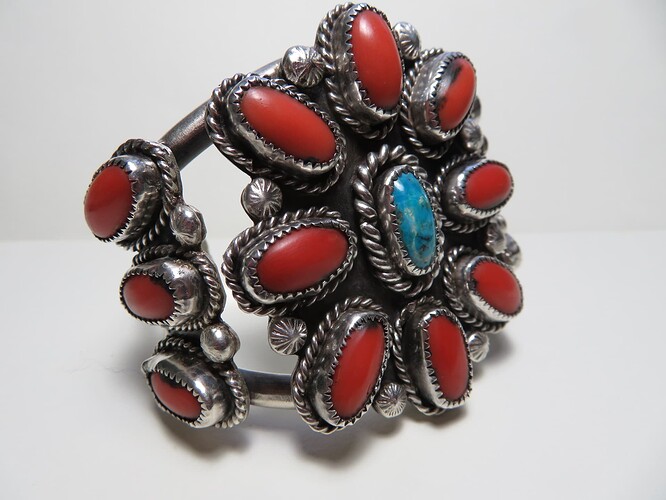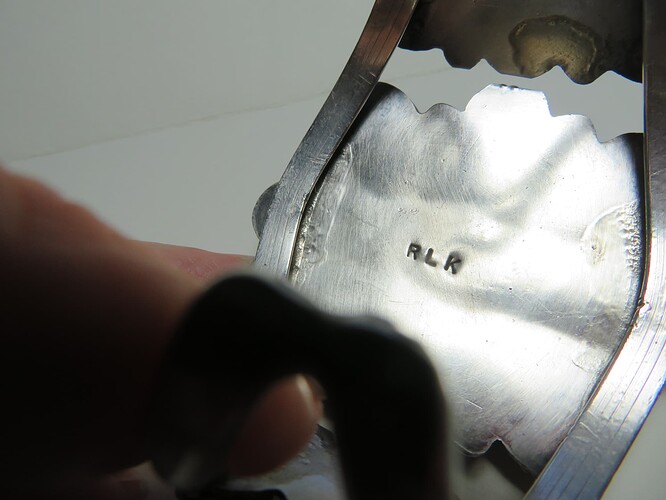This bracelet was purchased in New Mexico in the late 1960s or early '70s by a late friend. Its hallmark “RLK” is consistent with that of Zuni silversmiths Ralph and Lille Kallestewa but its cluster style is unlike any other piece I’ve seen attributed to them. All I’ve seen are pieces of inlaid stones and I can’t find any information online about this couple and their earlier works. Many thanks for any insights>
VeroBarb
Looks Navajo. Nothing about this bracelet looks like Zuni work. Coral stones are all European standard mm cuts, and very good quality. Turquoise could be high grade Persian - very rare nowadays.
This is likely a piece created for a trading company, or high end production shop with the business providing the matched stones to a skilled Navajo craftsperson.
I most sincerely thank you for your insights. I couldn’t agree with you more that this bracelet has so many elements indicative of Navajo work. It is a hefty piece and I am fairly familiar with Zuni work which, as you know, features less silver weight generally and has greater emphasis on the stonework. What has puzzled me since I received it is the “RLK” hallmark which is stamped identically to the one used by Ralph and Lillie Kallestewa. I couldn’t believe that this piece was theirs based on every thing else I’ve seen attributed to them but the hallmark is a puzzle. Is there a Navajo silversmith who used the very same “RLK” stamp?
Can you post a photo of the hallmark?
At that time (I estimate mid 70s give or take), there were a great number of highly skilled Navajo silversmiths with an entire alphabet soup of initials. An entire generation. There were also many non-Native silversmiths, old fashioned hippie silversmiths especially in places like Taos and Santa Fe, and as far away as Cortez and Durango Colorado who did beautiful work using traditional Navajo (or old Spanish) techniques. The emphasis in jewelry at that time was more about quality, than the nature of the origin, so one can’t really assume a piece of this caliber made during that period was necessarily of native origin. You may need to broaden your horizons in terms of to whom those initials belong, to find the maker.
Wish I could be of more help!
This almost looks like a ceremonial piece.
The depth of your knowledge and willingness to share it is deeply appreciated. I suppose I will never definitively know who was the maker of this piece but I would completely agree with you that it was not a Zuni artisan and assuredly not Ralph and Lillie Kallestewa! The bracelet originally was bought by my husband’s late college friend. They both attended a New Mexico university in the 1960s and it is likely that the friend Nora bought it thereabouts while still in school or on one of her many trips back to the southwest (she and my husband were from metro NYC and subsequently came to Florida). I was very fond of her and cherish this bracelet which her sister offered to me after Nora’s death. Your assistance in identifying it has been enlightening and I am obviously pleased that you think it is well-crafted! I thank you so much!
I love seeing pieces like this. Clearly it has tremendous personal and sentimental value for you. Technically speaking you have a real chunk of metalsmithing and lapidary history here.
The stones likely sit on a bed of sawdust. At one time they sat higher in the bezels, but the material underneath has settled over the years, allowing the stones to settle lower in the bezels than originally set.
If you wear the piece you’ll need to keep an eye on the settings as the additional space created between the stones and bezels from the sawdust settling creates an opportunity for the stones to loosen and fall out.
You might want to contact Jason to learn about having the stones reset more securely. If you choose to have this done, you’ll need someone with deep experience in these types of settings, as well as the handling of the natural coral - which is a separate consideration - as improper buffing and overheating (which can happen quickly) can ruin those beautiful stones.
Thank you for posting a photo of the back of the Bracelet, Barb. Everything I see confirms my impression that this is a production piece. It was certainly done skillfully, and with high quality materials, but I can also see from the way the solder was applied, the scoring on the back of the 1/2 round, and the saw work, that this was very likely a bracelet done in a ‘batch’ of bracelets as ‘piecework’, which is quite common for Navajo made jewelry of that era specifically created for sale to an enormous market of non-Native clientele.
Once again, I thank you most sincerely for shedding light on making of this bracelet. It is beautiful, but frankly somewhat “clunky” to wear and is a bit large for my wrist in any case. Since I have no one appropriate to leave it to, I suppose I’ll eventually try to sell it since the sentiments I have tied to the late friend who left it to me are kept in my heart and mind and not on my wrist! Your insights on this - and in other posts you’ve made - are so appreciated.
It’s a beautiful cuff. If it was my size I would buy it.


